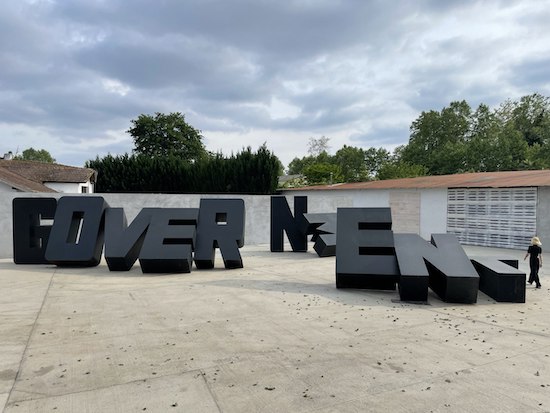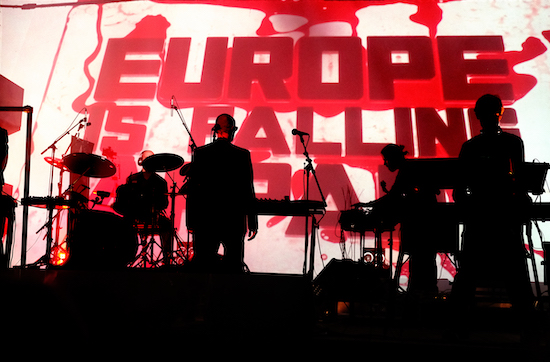DANGER live (Europe) credit Ari Matsuoka
I’m in Lourdes to see Laibach.
Lourdes is a site of Catholic pilgrimage, a church complex built around a small grotto where in 1858 a 14-year-old girl called Bernadette had 18 visions of the virgin. I was raised vaguely Catholic and went to Catholic schools, so every year teenagers from my school travelled here to help the elderly and the infirm submerge themselves in the water which is said to heal, and bottled water from the sacred source.
The basilica and grotto is at the end of a flag-lined avenue ending in an expanse of tarmac, which is marked in numbered squares. It would work as well outside of a government building as a church – a place for prostration in front of power, wherever one’s devotion is directed. It’s a holy site, but also one of teenage hallucination and ecstasy, and deeply appropriate precursor for tomorrow’s Laibach show. A century and a bit later, might Bernadette have lost her head to The Beatles?
The evening before the show I take a stroll around the town. The shops sell icons in wood, plastic, and metal; with LED lights or glow in the dark. There are troughs of moulded plastic bottles to fill with holy water, including ones small enough for hand luggage. Someone’s restocking the candles because the nightly torchlight procession is about to start. In one icon-stuffed shop they are piping out organ music and hymns; in the other is Coldplay.
Laibach’s performance takes place a little out of town, in an ex-foundry in a sleepy town called Maubourguet. Built in 1870 and later used as a munitions factory for supplying armaments to Nazi-occupied France, in the last decade it’s been restored by Russian dissident artist Andrei Molodkin and arts organisation, a/political. The walls are bare whitewash or raw plaster, rusted pulleys are left in place and chalk markings have been left on the bare girders, century-old sums totting up proportions of butane and propane. Molodkin and his family live between here and Paris (he can no longer travel to Russia) and a few days before we arrive he has been lambasted in the Russian press, for an eight-metre high projection of a portrait of Putin filled with Ukrainian blood that he installed in March at the altar of a church in central London.
The Foundry is focused on what a/political call ‘heavy production’, supporting “impossible projects” or large pieces that are often installed on site. Many of their affiliates are dissident artists making work that is direct, brutal, confrontational or transgressive; that blurs the lines between life and art. It includes Erik Bulatov’s large text paintings and Andres Serrano’s controversial Torture series, where volunteers agreed to submit themselves to real torture techniques and be photographed. Pyotr Pavlensky – who sewed his mouth shut and nailed his scrotum to Red Square – has worked here, as has Petr Davydtchenko, whose living art project involves him surviving mostly on roadkill. There are also a number of Molodkin’s blood and oil pieces here, including one in which DEMOCRACY appears in white neon, and is repeated below it in hollow acrylic letters being gradually filled by crude oil.

Unternehmen Barbarossa
It’s not a private space, as they have an open-door policy, but it also has no formal opening hours. It’s intended less as a gallery than somewhere work can be realised outside of the usual structures of the art world. It’s run by Andrei Molodkin and a/political, the organisation supporting this event. The latter is funded by its founder and co-director Andrei Tretyakov, a Russian venture capitalist and entrepreneur who lives in London. The courtyards also contain sculptures – words rendered in enormous 3D letters – GOVERNMENT and CAPITALISM both symbolically toppled over (although, perhaps the latter should be upright).
Being unveiled (or rather, unrolled) inside is a new artwork by Laibach called Unternehmen Barbarossa. It is their version of Guernica (made in part because they weren’t able to borrow the real Guernica). This one is a tapestry, made by hand by a family in Kabul, Afghanistan, the same dimensions as Picasso’s painting, and with a similar composition of images collaged from the prints of Slovenian artist Nikolaj Pirnat. In the centre, a speared horse rears in pain; sunken-faced children clutch at mothers; brutish soldiers hold a pistol to a woman’s throat; a black sun burns red.
From here, the tapestry will go on tour. The group’s mouthpiece, Ivan Novak, says that since the real Guernica was taken down by the Rockefeller estate, they’d like to get their tapestry hung in the UN in its place, and put it under the protection of Afghanistan. The Rockefellers recently put the real Guernica back, however, and diplomatic hurdles are posed by its title: Unternehmen Barbarossa was the name for the Nazi invasion of the Soviet Union, which aimed to exterminate Slavic people. The Germans in the image – as one politician fed back to Novak – also don’t come off very well.
The audience for the performance is small – perhaps 80 people in total, maybe 100. Around 60 are guests, and there are a handful of fans who could travel here and afford the tickets. We are fed with cured salmon and oysters and can help ourselves to wine as we wait for darkness to fall and the music to start. The guests are an odd mix as this is not really a press trip. There are a few journalists and music writers, along with a clutch of left or anarchist aligning curators, some artists and musicians, plus the former mayor of Sheffield (who arrives in a Gramsci T-shirt). Some have known Laibach since the 80s, some have never heard of them.
Before the set is an anti-war sermon by NSK philosopher Peter Mlakar that states: “War is the natural state of things. Is this really the whole truth and nothing but the truth? Is there no alternative?” It’s delivered by a member of the group inside a giant henge of red and black letters by Erik Bulatov, which reads FORWARD in Cyrillic. Then, the performance begins.
Laibach play inside another 3D text sculpture piece by Santiago Sierra, which creates a looming performance space that spells out TIRED OF THIS GLOBAL SADISTIC REGIME in 12ft tall black letters. The set is in two parts: the first a reconstruction of early material from 1982–83 (as is released on We Forge The Future. Live At Reina Sofía), the second contained songs from an upcoming project called Sketches of the Red Districts, which is a reflection on strikes and political upheavals in the Slovenian city of Trbovlje in 1924, and in 1980, when Laibach were formed.

DANGER live (Putin) credit Ari Matsuoka
It’s heavy, really heavy, and the syrupy bass vibrates my eyeballs. Many of the tracks are from early releases like Ljubljana–Zagreb–Beograd and Rekapitulacija 1980–84 – such as ‘Boji’ and ‘Smrt Za Smrt’ – delivered here with the extra pummel of much improved electronic equipment than those original recordings (and, as some long-time fans tell me, better sounding than those early live shows). Most of this material is also from the period before Laibach had adopted German and English as their chosen languages.
I had expected the hits for this in-between audience, but the pomp is left aside for a brutal well-tuned din; a vibratory squall of electronics and drums; an industrial murk punctuated by Kaoss pad, gong, sheet metal and speech. There are other unusual aspects too: Novak is also performing on stage; frontman Milan Fras has no headgear on, and only dips to his familiar growl once or twice. Both vocalists deliver lines mostly through a megaphone.
It is the seriousness of this show that is its making – there is very little of their fruity militaristic camp; no sense of pop subversion as with their cover versions. Perhaps, in the context of the war in Ukraine – and the personal proximity of it for many attendees – there is no place tonight for The Sound Of Music, for pointed Beatles or Queen covers.

Andrei Molodkin, Government Down, 2018
Additionally, the visuals are – unusually for Laibach – not in the hands of the group, but Molodkin’s. His Putin portrait flashes up towards the end, preceded by other blood-soaked slogans – some ‘sampled’ from Laibach lyrics and album titles, like NATO and ‘Europe is falling apart’ (from ‘Eurovision’ on Spectre) – interspersed with grainy grey and white military drone footage in which people on foot are followed grimly in crosshairs, often with hands above their heads, attempting retreat from airborne armaments. There’s little ambiguity – Molodkin’s work is purposefully brutalist and often directly critical of the Russian government – but the stomp and murk of the music (and the language barrier) maintains an indirectness, projecting mood but undermining the delivery of any explicit message.
I leave with a grim sense of reality, and step out to more free-flowing wine and food, but find I’ve lost my appetite.
The day after we are taken to a second venue in the mountains, La Raillere, recently purchased and as such, only half-renovated. Formerly a hydrothermal spa for the Victorian aristocracy, guests would submerge here in the healing thermal waters and freezing blue mountain streams. On the echoing stairs of the freshly plastered grand entrance hall, Laibach briefly but formally announce their next project: A collaboration with the Tehran Symphony Orchestra for a performance based on The Alamut, a 1938 novel by Slovenian writer Vladimir Bartol, set in the fortress of Alamut in Iran in the 11th century. The project is a collaboration with a/political, and is well underway: the music is written, and a documentary has begun filming. They are hoping to perform in Iran later this year, should diplomatic push and pull allow.
Novak says that people they have explained the project to have asked – as they did with North Korea – why Laibach are playing. Are they supporting the regime? No, they’re not supporting the regime, says Novak, but are “supporting people who decided to stay in Iran, despite everything.”
“Art is fanaticism that demands diplomacy,” he says.
Of the subversive industrial cohort of the 1980s, Laibach’s strategy might be the only one that still works, provoking a challenge with each new project. References to fascism or perversions, as employed by some of Laibach’s peers back then, made music that challenged not just aural sensibilities but also social norms and moral codes. Some of this music now rings a little hollow, or prompts a redoubled horror at the state of things, where entire online communities support the practices much worse than any industrial group ever cooked up. With war in Europe again, are Laibach more relevant than ever before?
A serious performance about war and the dissolution of nations while the audience eats oysters and networks; a diplomatic pipe dream for a rug named after a Nazi invasion; a musical project in Iran that makes a North Korea gig look easy. Capitalism and dissidence; diplomacy and art; nothing is simple and everything is ambiguous. I just don’t know what to make of it. Laibach strikes again.


